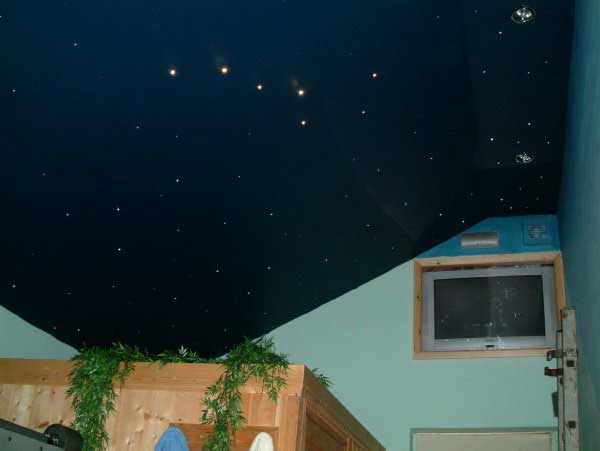One of Starscape’s Custom Star Kits was the starting point for an interesting Spa Room lighting project carried out by T.I. of Altringham, ably assisted by his wife.
The layout of the room presented some challenges, but this couple rose to the occasion
and successfully completed an impressive job, as they describe here:

The fibres were first fitted to mdf panels and the panels were then offered up to the ceiling.
“As you can see from the installation photographs, the arrangement of the ceiling was such that the fibres had to be fed in from underneath.
Therefore, we insulated the ceiling, and retained this with battens.
These battens were strategically placed to support the false ceiling boards.
The boards were initially fitted, then removed to allow the holes for the fibres to be drilled.
The fibres were then fed in from above, and glued in place using some ‘No More Nails’.
Once the fibres were fitted the board was lifted into place and fixed with screws.
(As the ceiling was to be dark, the screws would not show up.)
The lightsource was positioned in an accessible void above an adjacent room.

The fibre optic stars shine brightly against a dark blue background, although they show up perfectly
well against a white ceiling too, if you don’t want to darken the overall decor of the room.
Once fully installed, we decided to paint the ceiling and the fibres.
The paint on the fibres gave a slightly dull effect to the stars which we felt was much improved.
Let me just add that we are very happy with the final effect, but there is always room to improve, isn’t there!
The star effect is used in our application when little if no other light is present
(It is our Spa room, and the only other light source used – when relaxing – is the tub lighting).
This makes the stars very bright, and therefore in our application stand out more.
Besides, the blue paint on the stars does seem to give it more of a night sky feel (for some reason).
The position of the Plough (Seen in the photos) was roughly as we would see it from our home,
and generated using 2 or 3 fibres together, this we found to be unnecessary after the painting exercise.
If we were to do this again, we would probably use smaller sections of board,
and longer fibres (allowing the boards to drop to the floor while installing).
The mural on the walls is not yet complete, so don’t look at the walls too much!
The installation was difficult but not impossible, and it has proven to be a fantastic conclusion!”
